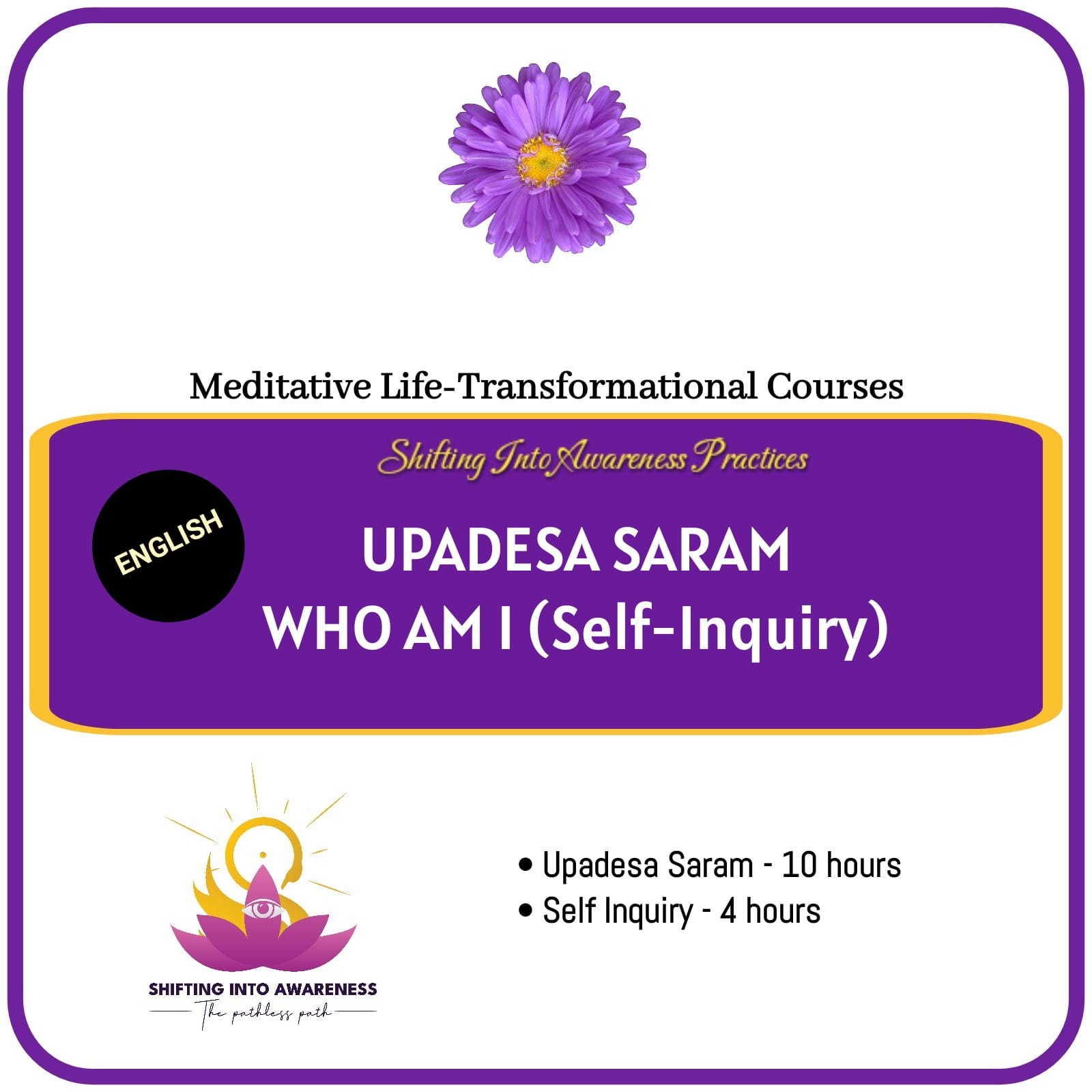Description
It is less known that Upadesa Saram is the best bridge to lead to the WHO AM I practice but since Upadesa Saram also is difficult to perceive rightly due to its poetic and coded language, this powerful scripture is also not much popular as it should be.
With the grace of Arunachala and Bhagwan Ramana (without which it is impossible), it has been made as simple as possible with detailed clarity on each and very verse of Upadesa Saram that leads to the WHO AM I (Atma Vichara) practice.
******
What is Upadesa Saram?
Amongst the original works of Bhagavan Sri Ramana Maharshi, Upadesa Saram is unique for its beauty of phrase, breadth of scope, organisation of thought, and brevity of expression. It is also one of the most accessible of Bhagavan’s works. In just thirty pithy verses, Bhagavan presents the entire range of sadhana in an encapsulated form suited to followers not only of the principal paths of jnana (the practice of atma-vichara or self-investigation) and bhakti (devotion) but also of the subsidiary paths of niskamya karma (desireless action) and yoga (the practice of techniques such as breath-restraint as a means to restrain the mind). It is a sign of the greatness of this work that Bhagavan, after first writing it in Tamil, himself rendered it into three other languages — Sanskrit, Telugu and Malayalam. No other work of his has been accorded such special distinction and it is no wonder that the Sanskrit version is rated as a scripture and recited daily at the Ashram during Vedaparayana.
●●●
“This webinar is my personal favourite and will be a much relished delight to help seekers where they stand in spiritual evolution ladder and what to look forward to in enthusiasm and what to leave behind without guilt.” ~ Jake Light
Upadesha Saram is a comprehensive work presenting the entire Vedic teaching in a nutshell. It presents all Sadhana’s in a nut shell.
Like other works of Ramana MahaRishi, Upadesha Saram was written at the request of a devotee. Ramana himself was not inclined towards Vedantic writing. It was his devotee Murugesan who asked him to write this book. Murugesan was a Tamil scholar. He was writing a book based upon a story of the puranas. In this story, Shiva comes to the world as a Vedantic Guru or Rishi. The story goes that some ascetic householders attached to the Karma Kandi or Poorva Mimasa tradition were performing a Yaga. Poorva Mimamsi’s or Karma Kandi’s believed in rituals. They believed rituals would take them to heaven (Swarga). They also believed rituals, would give them the four Goals of Hindu Life: Kama, Artha, Dharma & Moksha .
Furthermore, they believed that rituals themselves gave the phalams and one need not believe in God. They believed Veda is eternal, world is eternal, and rituals themselves give us what we want without a God . They were non-believing Atheistic People. Due to some obstacle they were not able to come out of Karma Kanda. Lord Shiva wanted to help them and educate them. So, Shiva staged a drama. Murugesan wanted to write about this.
The story goes, one day these Rishi’s decided to perform a Yaga. At that time Shiva called Vishnu and requested his help. They were friends. Shiva wanted Vishnu to come down as Mohini. He agreed to come down himself as an enchanting Brahmachari Bikshu. He suggested they ask the Rishi’s and Rishi’s wives respectively, for Bhiksha. Mohini decided to go to the Yagashala. The Rishi’s saw Mohini and enchanted by her, followed her. But suddenly she disappeared. They realized something was wrong and they returned embarrassed. Upon return they noticed that their wives were not there.
At the same time Shiva as a Bhikshu had gone to the houses of Rishi’s and their wives seeing his enchanting form followed him. The Rishi’s ran back home and saw their wives following Shiva. In anger the Rishi’s attacked Shiva and used the mantra Abhicharaka Karmani to destroy him. Shiva, however, just stood and smirked at them. The Rishi’s understood that there was something wrong with their rituals. Then, in defeat, they surrendered to the Bhikshu. Now, Shiva coming into his form taught them the limitations of Karma. They were told they have to come to Atma Gyanam. This was taught to Karma Kandi Rishi’s in Darukavanam in Darukavana Upadesha. This was the story in
Puranas that Murugesan was writing about. He was at the stage of writing about Shiva’s Upadesha. He wanted Ramana MahaRishi to complete the Upadesha part. Murugesan was a great Bhakta of Ramana and he believed Ramana was Lord Shiva himself. Acceding to his request Ramana MahaRishi composed Shiva Darukavanam Upadesha Sara. Upadesha means teaching while Sara means essence of.









